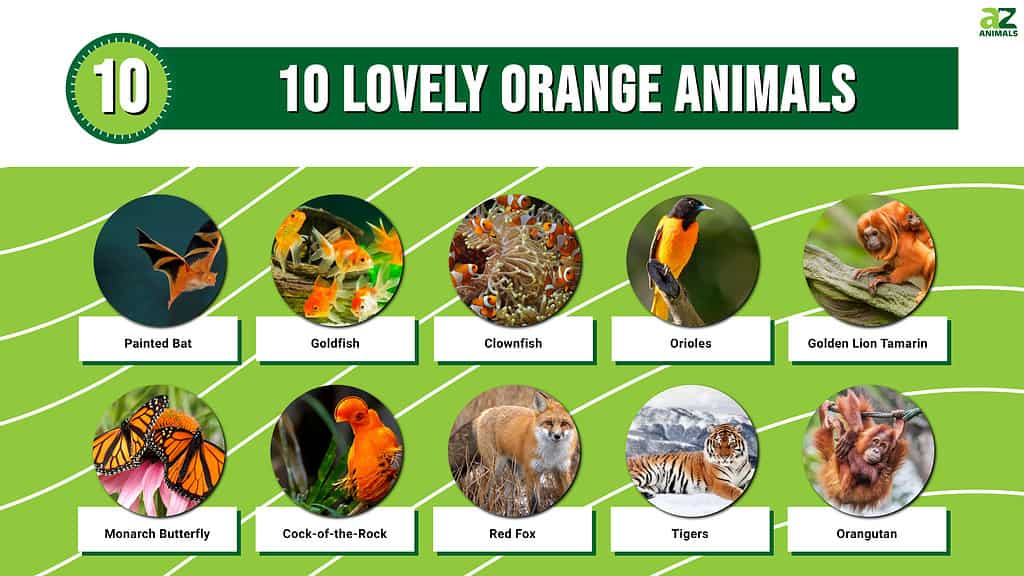
The color orange has many different practical uses in the animal kingdom. A bright and lavish display of orange feathers can help a bird attract a mate. Or the stealthy movements of the orange tiger, whose prey may perceive the fur as green, can help it ambush an unsuspecting target. This list will cover the top 10 most lovely animals with orange fur, skin, scales, or feathers in the wild. All of the orange animals must impress a human viewer in some way.
#10: Painted Bat

©PITOON KITRATANASAK/Shutterstock.com
A native of southern Asia, the painted bat possesses long, wooly orange or white hair over much of its body, while the wing membranes are covered in black. This color scheme may provide camouflage to help them blend in with their roosting sites, which can include tree hollows, trunks, dense foliage, and human buildings or huts, where they make use of echolocation to help them navigate their environments. Painted bats appear to form small nuclear family units which consist of a breeding pair and their immediate offspring. Most of the time they produce only a single pup per breeding season. Unfortunately, there are still many things we don’t understand yet about this fascinating species.
#9: Goldfish
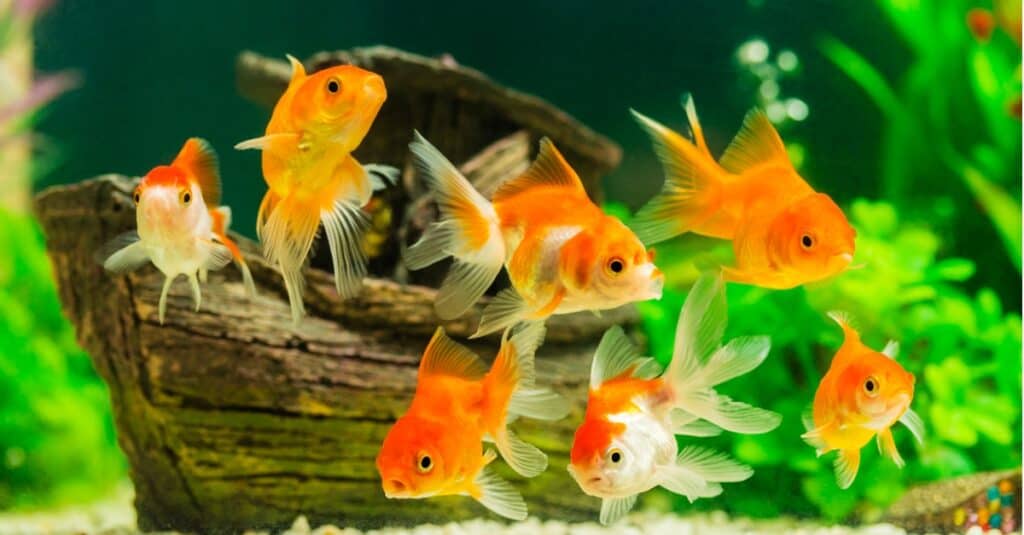
©iStock.com/satit_srihin
The goldfish is a lovely orange animal that comes from a small freshwater brown or gray carp, native to East Asia. More than a thousand years ago in imperial China, the species were selectively bred for domestication. It began to acquire many distinctive sizes, body shapes, fin configurations, and colors. Golden orange is by far the most popular in the aquarium trade, but yellow, brown, white, and black are also possible.
There are more than 125 different breeds of goldfish in total, some with swollen hoods on the head and others with upturned eyes. They can live up to 25 years in captivity, although the average lifespan is 10 to 15 years.
#8: Clownfish
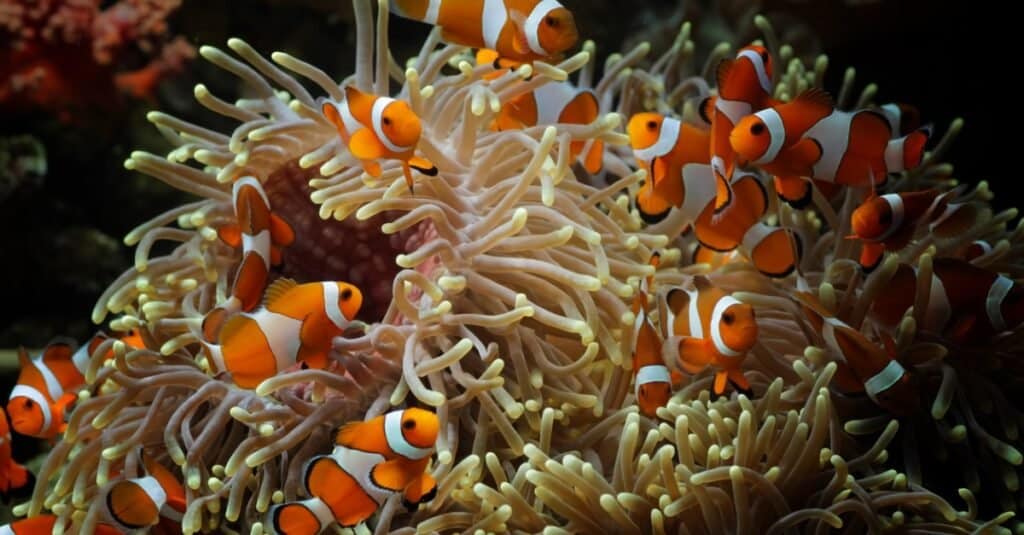
©iStock.com/agus fitriyanto
The clownfish is a group of some 30 species that form a mutual relationship with sea anemones. The species you’re probably most familiar with (both because of its popularity in the aquarium trade and from the film “Finding Nemo”) is the common or ocellaris clownfish, which is characterized by three white vertical rings separated by black lines around its orange body. Many species are endemic to the Indian and Pacific oceans. They have evolved the ability to acquire immunity to the toxins of their host anemones by carefully touching the tentacles with a different part of their bodies to build up a layer of mucous. The anemone provides a safe haven from dangerous predators, while the fish brings food to the anemone and preens it for parasites.
#7: Orioles
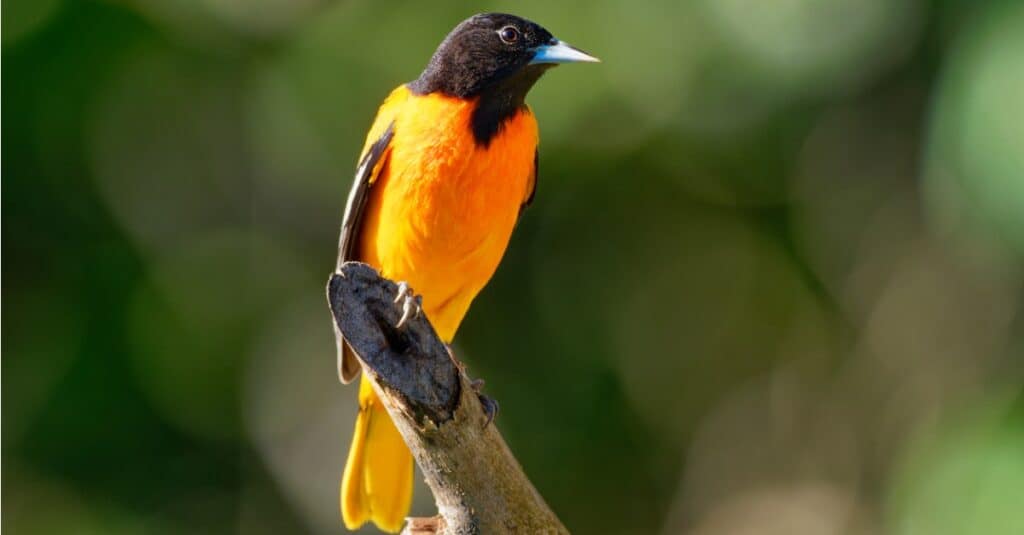
©iStock.com/phototrip
Orioles are a large group of songbirds with slender bodies and pointed bills. There are dozens of different species, divided into New World or Old World types. Males have contrasting yellow or orange bodies with black heads and backs, whereas the females and juvenile birds tend to have duller gray plumage. The reason why male birds tend to be more colorful than females is that the intensity of the plumage tends to be a sign of his health and vitality, which makes them more desirable in the reproductive season. The most well-known species (perhaps due to the baseball team) is the Baltimore oriole of the eastern part of North America. Males can appear anywhere from yellowish orange to deep, intense orange.
#6: Golden Lion Tamarin

©iStock.com/Enjoylife2
This small endangered monkey, which lives in the coastal forests of Brazil, gets its name from the bright ginger hair that covers almost everything except for the bare face and feet. While the body only measures about six to 10 inches long, the tail is comparatively enormous — it can reach between 12 and 15 inches, enabling them to cling easily to trees.
In the wild, this tamarin lives in small family units of two to eight individuals. The family consists of a breeding pair, their offspring, and any close relatives. After mating, the female will usually give birth to twins; both the offspring are born fully furred and with their eyes open. They sleep together in tree holes during the night for both warmth and protection.
You can read more about the golden lion tamarin here.
#5: Monarch Butterfly
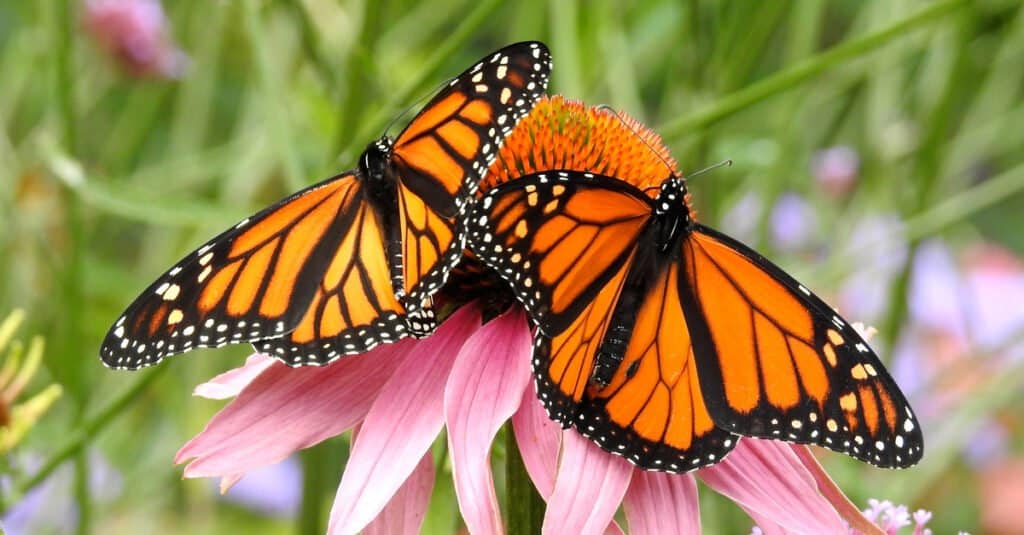
©Kate Besler/Shutterstock.com
Monarch butterflies are lovely orange animals that are characterized by large wings, measuring up to four inches long, with tawny orange areas separated by white veins that make it look somewhat like stained glass. White spots also occur around the fringes of the wings. Monarch butterflies produce four generations per year, each one living about four to five weeks long. Only this last generation undertakes the migration south for the winter. When it completes the journey (up to 2,800 miles in some cases), the butterfly hibernates in the mild temperatures of the mountain forests. It makes the opposite journey north in the spring to begin the entire reproductive cycle over again.
The larvae depend on milkweed plants throughout their entire range to feed on until they’re ready to complete the metamorphosis into adults.
#4: Cock-of-the-Rock
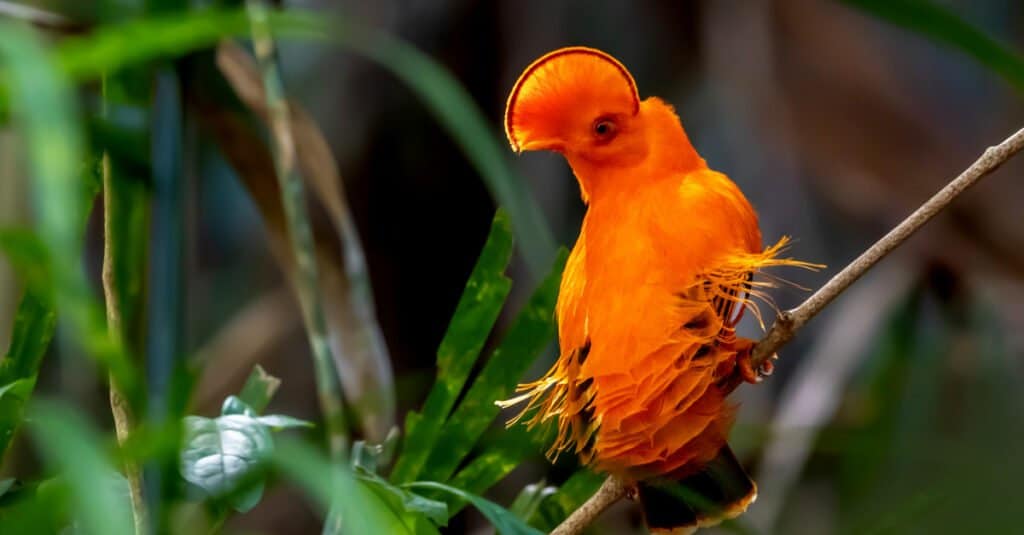
©Wang LiQiang/Shutterstock.com
Most people have probably never heard of the two species (the Andean and the Guianan cock-of-the-rock) that form this genus of perching songbirds. Both species are native to the humid forests of South America at elevations up to nearly 8,000 feet. The males are covered in bright orange and gray/black plumage with a huge crest emerging from his head, whereas the much more demure female has duller plumage and a smaller crest.
The reproductive season for the cock-of-the-rock begins when the birds gather together in a ritualized courtship display called a lek. The mere sight of the female is enough to trigger an intense dance competition among the males. She will then choose the best male dancer by nibbling at his feathers or pecking his neck. Some males will have multiple mates per season, while others may have none. The chicks hatch with small ginger tufts of down feathers that grow in all directions, which can make them appear very comical.
#3: Red Fox
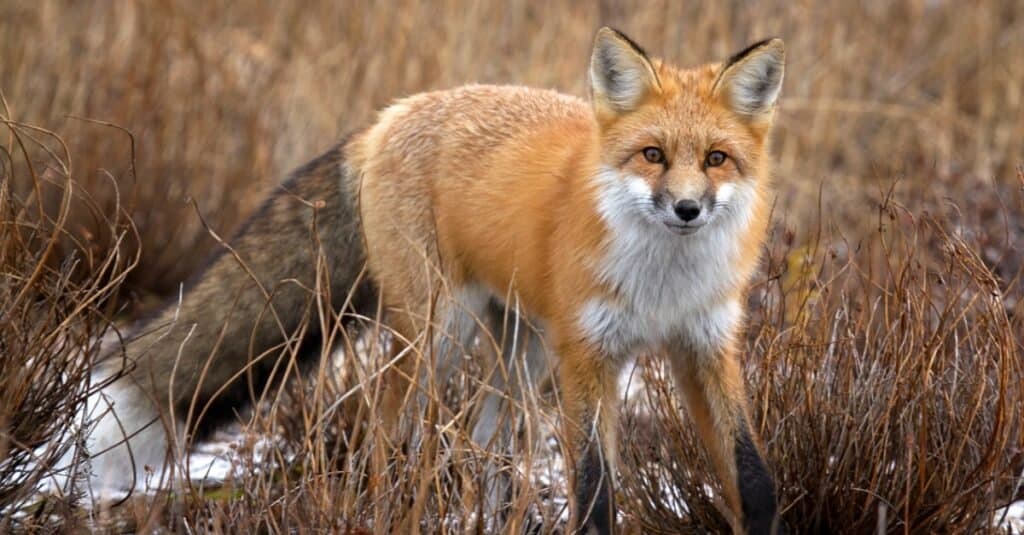
©iStock.com/Lynn_Bystrom
The red fox is one of the most common animals in all of North America. Measuring about 36 to 42 inches long, it is covered in reddish-orange fur color with a white chest and black markings around the tail and feet. It has numerous other color morphs as well, including gray, silver, and cross. Their preferred habitats are mixed forest and grasslands ecosystems, but they can conceivably live anywhere, from deserts to tundra. These highly adaptable animals have even thrived next to human cities and suburbs.
Their dense reddish-orange fur, which consists of a soft undercoat and long outer guard hairs, is highly prized by people. Many of them are raised in fox farms until about 10 months off age to make clothing. They have also been the traditional target of the popular sport of fox hunting for many thousands of years.
#2: Tigers
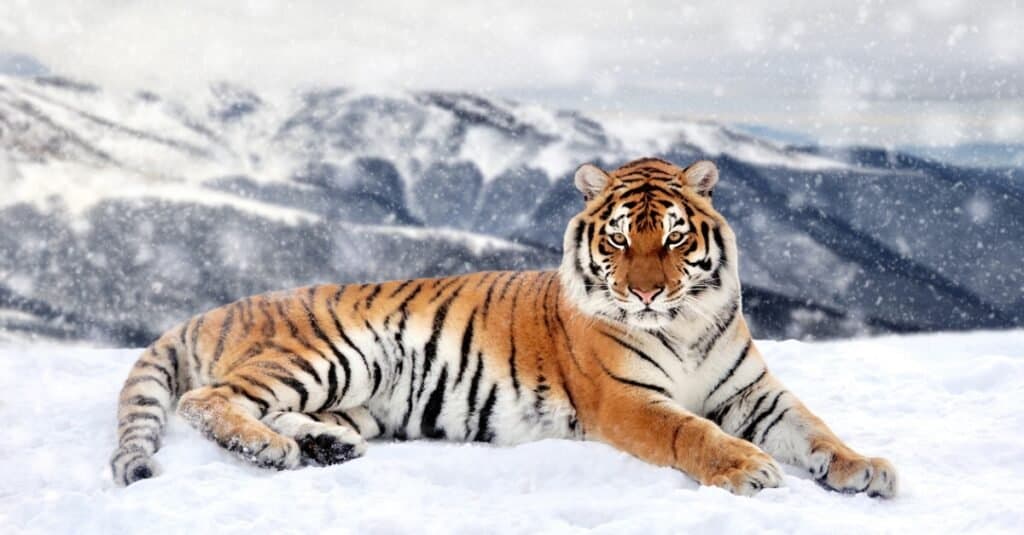
©iStock.com/Byrdyak
The tiger is the largest living cat species in the world, but it has become rare and endangered over the past few centuries. Several distinctive subspecies are recognized, including the Bengal tiger, Siberian tiger, and Indochinese tiger. Tigers come in various shades of orange and brown with white areas on the underside and black stripes along the entire back, face, and tail, each pattern being unique to the individual like a fingerprint to a human. There are three additional color variations: golden, white with stripes, and white with hardly any stripes at all. These rare color morphs are hardly found in the wild anymore, but they are carried on in captivity.
#1: Orangutan
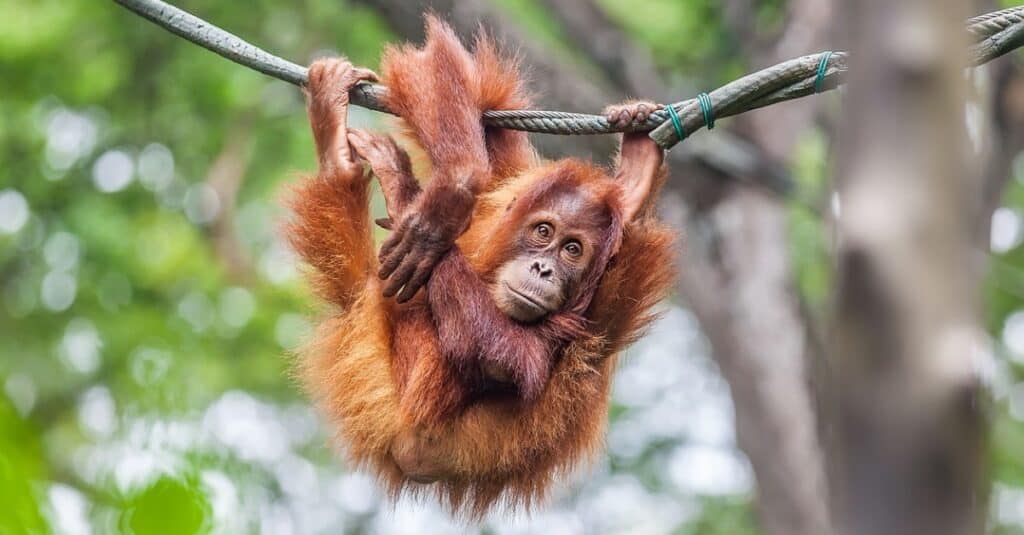
©iStock.com/molishka1988
The orangutan takes the spot among the loveliest orange animals in the world. It is a genus of three orange-colored primate species, two of them from the Pacific island of Sumatra and another from Borneo. With their long powerful limbs, orangutans spend most of their time in trees, foraging for wild fruits such as figs, mangosteens, and lychees. Dominant males, which can weigh up to 200 pounds, are also known as “flanged males.” They develop prominent flanged cheek pads and a large throat sac that enables them to make loud calls. An unflanged male lower in the group hierarchy looks a bit like a female. Ginger or brown fur covers most of their bodies except for the hairless faces, but some males do develop a long beard as well.
Unfortunately, orangutans are becoming rare throughout their natural range. While numbers stood at some 230,000 in the early 20th century, populations have now been cut almost in half.
Our research shows that the top ten most lovely orange animals are as follows:
| Animal | Color used for: | |
|---|---|---|
| 1. | Orangutan | Camouflage |
| 2. | Tigers | Camouflage |
| 3. | Red Fox | Camouflage |
| 4. | Cock-of-the-Rock | Exhibition |
| 5. | Monarch Butterfly | Exhibition |
| 6. | Golden Lion Tamarin | Camouflage |
| 7. | Orioles | Exhibition |
| 8. | Clownfish | Exhibition |
| 9. | Goldfish | Exhibition |
| 10. | Painted Bat | camouflage |
Up Next…
- Meet the World’s Weirdest Crocodile Species (They’re Orange and Live in Caves!) Yes, there are orange crocodiles! Check out another animal that uses orange as camouflage.
- 8 Orange Snakes In Florida Is anyone surprised that Florida has 8 types of orange snakes?
- 8 Orange Cat Breeds & Orange Cat Names Some orange critters come in the cute and cuddly variety.
The photo featured at the top of this post is © iStock.com/molishka1988
Thank you for reading! Have some feedback for us? Contact the AZ Animals editorial team.






